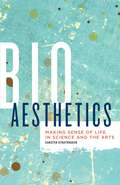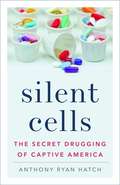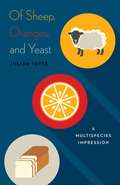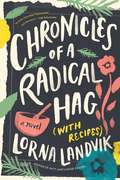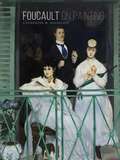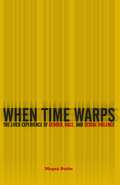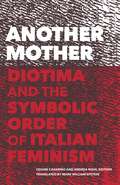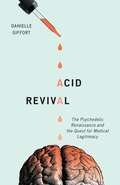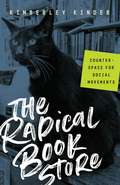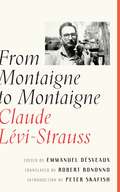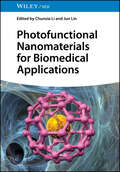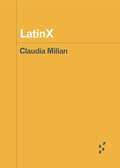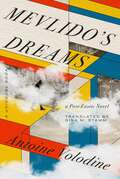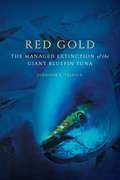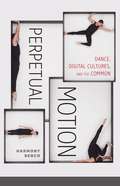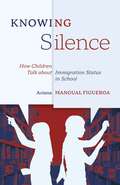- Table View
- List View
Bioaesthetics: Making Sense of Life in Science and the Arts (Posthumanities #43)
by Carsten StrathausenIn recent years, bioaesthetics has used the latest discoveries in evolutionary studies and neuroscience to provide new ways of looking at art and aesthetics. Carsten Strathausen&’s remarkable exploration of this emerging field is the first comprehensive account of its ideas, as well as a timely critique of its limitations. Strathausen familiarizes readers with the basics of bioaesthetics, grounding them in its philosophical underpinnings while articulating its key components. Importantly, he delves into the longstanding problem of the &“two cultures&” that separate the arts and the sciences. Seeking to make bioaesthetics a more robust way of thinking, Strathausen then critiques it for failing to account for science&’s historical and cultural assumptions. At its worst, he says, biologism reduces artworks to mere automatons that rubber-stamp pre-established scientific truths. Written with a sensitive understanding of science&’s strengths, and willing to refute its best arguments, Bioaesthetics helps readers separate the sensible from the specious. At a time when humanities departments are shrinking—and when STEM education is on the rise—Bioaesthetics makes vital points about the limitations of science, while lodging a robust defense of the importance of the humanities.
Silent Cells: The Secret Drugging of Captive America
by Anthony Ryan HatchA critical investigation into the use of psychotropic drugs to pacify and control inmates and other captives in the vast U.S. prison, military, and welfare systemsFor at least four decades, U.S. prisons and jails have aggressively turned to psychotropic drugs—antidepressants, antipsychotics, sedatives, and tranquilizers—to silence inmates, whether or not they have been diagnosed with mental illnesses. In Silent Cells, Anthony Ryan Hatch demonstrates that the pervasive use of psychotropic drugs has not only defined and enabled mass incarceration but has also become central to other forms of captivity, including foster homes, military and immigrant detention centers, and nursing homes. Silent Cells shows how, in shockingly large numbers, federal, state, and local governments and government-authorized private agencies pacify people with drugs, uncovering patterns of institutional violence that threaten basic human and civil rights. Drawing on publicly available records, Hatch unearths the coercive ways that psychotropics serve to manufacture compliance and docility, practices hidden behind layers of state secrecy, medical complicity, and corporate profiteering.Psychotropics, Hatch shows, are integral to &“technocorrectional&” policies devised to minimize public costs and increase the private profitability of mass captivity while guaranteeing public safety and national security. This broad indictment of psychotropics is therefore animated by a radical counterfactual question: would incarceration on the scale practiced in the United States even be possible without psychotropics?
Of Sheep, Oranges, and Yeast: A Multispecies Impression (Posthumanities #40)
by Julian YatesIn what senses do animals, plants, and minerals &“write&”? How does their &“writing&” mark our livesour past, present, and future? Addressing such questions with an exhilarating blend of creative flair and theoretical depth, Of Sheep, Oranges, and Yeast traces how the lives of, yes, sheep, oranges, gold, and yeast mark the stories of those animals we call &“human.&”Bringing together often separate conversations in animal studies, plant studies, ecotheory, and biopolitics, Of Sheep, Oranges, and Yeast crafts scripts for literary and historical study that embrace the fact that we come into being through our relations to other animal, plant, fungal, microbial, viral, mineral, and chemical actors. The book opens and closes in the company of a Shakespearean character talking through his painful encounter with the skin of a lamb (in the form of parchment). This encounter stages a visceral awareness of what Julian Yates names a &“multispecies impression,&” the way all acts of writing are saturated with the &“writing&” of other beings. Yates then develops a multimodal reading strategy that traces a series of anthropo-zoo-genetic figures that derive from our comaking with sheep (keyed to the story of biopolitics), oranges (keyed to economy), and yeast (keyed to the notion of foundation or infrastructure). Working with an array of materials (published and archival), across disciplines and historical periods (Classical to postmodern), the book allows sheep, oranges, and yeast to dictate their own chronologies and plot their own stories. What emerges is a methodology that fundamentally alters what it means to read in the twenty-first century.
Chronicles of a Radical Hag (with Recipes): A Novel
by Lorna LandvikA bittersweet, seriously funny novel of a life, a small town, and a key to our troubled times traced through a newspaper columnist&’s half-century of taking in, and taking on, the world The curmudgeon who wrote the column &“Ramblin&’s by Walt&” in the Granite Creek Gazette dismissed his successor as &“puking on paper.&” But when Haze Evans first appeared in the small-town newspaper, she earned fans by writing a story about her bachelor uncle who brought a Queen of the Rodeo to Thanksgiving dinner. Now, fifty years later, when the beloved columnist suffers a massive stroke and falls into a coma, publisher Susan McGrath fills the void (temporarily, she hopes) with Haze&’s past columns, along with the occasional reprinted responses from readers. Most letters were favorable, although Haze did have her trolls; one Joseph Snell in particular dubbed her &“liberal&” ideas the &“chronicles of a radical hag.&” Never censoring herself, Haze chose to mollify her critics with homey recipes—recognizing, in her constantly practical approach to the world and her community, that buttery Almond Crescents will certainly &“melt away any misdirected anger.&”Framed by news stories of half a century and annotated with the town&’s chorus of voices, Haze&’s story unfolds, as do those of others touched by the Granite Creek Gazette, including Susan, struggling with her troubled marriage, and her teenage son Sam, who—much to his surprise—enjoys his summer job reading the paper archives and discovers secrets that have been locked in the files for decades, along with sad and surprising truths about Haze&’s past. With her customary warmth and wit, Lorna Landvik summons a lifetime at once lost and recovered, a complicated past that speaks with knowing eloquence to a confused present. Her topical but timeless Chronicles of a Radical Hag reminds us—sometimes with a subtle touch, sometimes with gobsmacking humor—of the power of words and of silence, as well as the wonder of finding in each other what we never even knew we were missing.
Foucault on Painting
by Catherine M. SoussloffMichel Foucault had been concerned about painting and the meaning of the image from his earliest publications, yet this aspect of his thought is largely neglected within the disciplines of art history and aesthetic theory. In Foucault on Painting, Catherine M. Soussloff argues that Foucault&’s sustained engagement with European art history critically addresses present concerns about the mediated nature of the image in the digital age.Foucault&’s writing on painting covers four discrete periods in European art history (seventeenth-century southern Baroque, mid-nineteenth century French painting, Surrealism, and figurative painting in the 1960s and &‘70s) as well as five individual artists: Velázquez, Manet, Magritte, Paul Reyberolle, and Gérard Fromanger. As Soussloff reveals in this book, Foucault followed a French intellectual tradition dating back to the seventeenth century, which understands painting as a separate area of knowledge. Painting, a practice long considered silent in its operations and effects, afforded Foucault an ideal discipline to think about history and philosophy simultaneously. Using a comparative approach grounded in art history and aesthetics, Soussloff explores the meaning of painting for Foucault&’s philosophy, and for contemporary art theory, proposing a new relevance for a Foucauldian view of ethics and the pleasures and predicaments of contemporary existence.
When Time Warps: The Lived Experience of Gender, Race, and Sexual Violence
by Megan BurkeAn inquiry into the phenomenology of &“woman&” based in the relationship between lived time and sexual violence Feminist phenomenologists have long understood a woman&’s life as inhibited, confined, and constrained by sexual violence. In this important inquiry, author Megan Burke both builds and expands on this legacy by examining the production of normative womanhood through racist tropes and colonial domination. Ultimately, Burke charts a new feminist phenomenology based in the relationship between lived time and sexual violence. By focusing on time instead of space, When Time Warps places sexualized racism at the center of the way &“woman&” is lived. Burke transports questions of time and gender outside the realm of the historical, making provocative new insights into how gendered individuals live time, and how their temporal existence is changed through particular experiences.Providing a potent reexamination of the theory of Simone de Beauvoir—while also bringing to the fore important women of color theorists and engaging in the temporal aspects of #MeToo—When Time Warps makes a necessary, lasting contribution to our understanding of gender, race, and sexual violence.
Another Mother: Diotima and the Symbolic Order of Italian Feminism (Cultural Critique Books)
by Andrea Righi Cesare CasarinoA groundbreaking volume introduces the unique feminist thought of the longstanding Italian group known as Diotima Introducing Anglophone readers to a potent strain of Italian feminism known to French, Spanish, and German audiences but as yet unavailable in English, Another Mother argues that the question of the mother is essential to comprehend the matrix of contemporary culture and society and to pursue feminist political projects. Focusing on Diotima, a community of women philosophers deeply involved in feminist politics since the 1960s, this volume provides a multifaceted panorama of its engagement with currents of thought including structuralism, psychoanalysis, linguistics, and Marxism. Starting from the simple insight that the mother is the one who gives us both life and language, these thinkers develop concepts of the mother and sexual difference in contemporary society that differ in crucial ways from both French and U.S. feminisms. Arguing that Diotima anticipates many of the themes in contemporary philosophical discourses of biopolitics—exemplified by thinkers such as Giorgio Agamben, Antonio Negri, and Roberto Esposito—Another Mother opens an important space for reflections on the past history of feminism and on feminism&’s future. Contributors: Anne Emmanuelle Berger, Paris 8 U–Vincennes Saint-Denis; Ida Dominijanni; Luisa Muraro; Diana Sartori, U of Verona; Chiara Zamboni, U of Verona.
Ugly White People: Writing Whiteness in Contemporary America
by Stephanie LiWhiteness revealed: an analysis of the destructive complacency of white self-consciousness White Americans are confronting their whiteness more than ever before, with political and social shifts ushering in a newfound racial awareness. And with white people increasingly seeing themselves as distinctly racialized (not simply as American or human), white writers are exposing a self-awareness of white racialized behavior—from staunch antiracism to virulent forms of xenophobic nationalism. Ugly White People explores representations of whiteness from twenty-first-century white American authors, revealing white recognition of the ugly forms whiteness can take. Stephanie Li argues that much of the twenty-first century has been defined by this rising consciousness of whiteness because of the imminent shift to a &“majority minority&” population and the growing diversification of America&’s political, social, and cultural institutions. The result is literature that more directly grapples with whiteness as its own construct rather than a wrongly assumed norm. Li contextualizes a series of literary novels as collectively influenced by changes in racial and political attitudes. Turning to works by Dave Eggers, Sarah Smarsh, J. D. Vance, Claire Messud, Ben Lerner, and others, she traces the responses to white consciousness that breed shared manifestations of ugliness. The tension between acknowledging whiteness as an identity built on domination and the failure to remedy inequalities that have proliferated from this founding injustice is often the source of the ugly whiteness portrayed through these narratives. The questions posed in Ugly White People about the nature and future of whiteness are vital to understanding contemporary race relations in America. From the election of Trump and the rise of white nationalism to Karen memes and the war against critical race theory to the pervasive pattern of behavior among largely liberal-leaning whites, Li elucidates truths about whiteness that challenge any hope of national unity and, most devastatingly, the basic humanity of others. Retail e-book files for this title are screen-reader friendly.
Acid Revival: The Psychedelic Renaissance and the Quest for Medical Legitimacy
by Danielle GiffortA vivid analysis of the history and revival of clinical psychedelic science Psychedelic drugs are making a comeback. In the mid-twentieth century, scientists actively studied the potential of drugs like LSD and psilocybin for treating mental health problems. After a decades-long hiatus, researchers are once again testing how effective these drugs are in relieving symptoms for a wide variety of psychiatric conditions, from depression and obsessive–compulsive disorder to posttraumatic stress disorder and substance addiction. In Acid Revival, Danielle Giffort examines how this new generation of researchers and their allies are working to rehabilitate psychedelic drugs and to usher in a new era of psychedelic medicine. As this team of researchers and mental health professionals revive the field of psychedelic science, they are haunted by the past and by one person in particular: psychedelic evangelist Timothy Leary. Drawing on extensive archival research and interviews with people working on scientific psychedelia, Giffort shows how today&’s researchers tell stories about Leary as an &“impure&” scientist and perform his antithesis to address a series of lingering dilemmas that threaten to rupture their budding legitimacy. Acid Revival presents new information about the so-called psychedelic renaissance and highlights the cultural work involved with the reassembly of dormant areas of medical science. This colorful and accessible history of the rise, fall, and reemergence of psychedelic medicine is infused with intriguing narratives and personalities—a story for popular science aficionados as well as for scholars of the history of science and medicine.
The Radical Bookstore: Counterspace for Social Movements
by Kimberley KinderExamines how radical bookstores and similar spaces serve as launching pads for social movements How does social change happen? It requires an identified problem, an impassioned and committed group, a catalyst, and a plan. In this deeply researched consideration of seventy-seven stores and establishments, Kimberley Kinder argues that activists also need autonomous space for organizing, and that these spaces are made, not found. She explores the remarkably enduring presence of radical bookstores in America and how they provide infrastructure for organizing—gathering places, retail offerings that draw new people into what she calls &“counterspaces.&”Kinder focuses on brick-and-mortar venues where owners approach their businesses primarily as social movement tools. These may be bookstores, infoshops, libraries, knowledge cafes, community centers, publishing collectives, thrift stores, or art installations. They are run by activist-entrepreneurs who create centers for organizing and selling books to pay the rent. These spaces allow radical and contentious ideas to be explored and percolate through to actual social movements, and serve as crucibles for activists to challenge capitalism, imperialism, white privilege, patriarchy, and homophobia. They also exist within a central paradox: participating in the marketplace creates tensions, contradictions, and shortfalls. Activist retail does not end capitalism; collective ownership does not enable a retreat from civic requirements like zoning; and donations, no matter how generous, do not offset the enormous power of corporations and governments. In this timely and relevant book, Kinder presents a necessary, novel, and apt analysis of the role these retail spaces play in radical organizing, one that demonstrates how such durable hubs manage to persist, often for decades, between the spikes of public protest.
From Montaigne to Montaigne
by Claude Lévi-StraussTwo previously unpublished lectures charting the renowned anthropologist&’s intellectual engagement with the sixteenth-century French essayist Michel de Montaigne In January 1937, between the two ethnographic trips he would describe in Tristes Tropiques, Claude Lévi-Strauss gave a talk to the Confédération générale du travail in Paris. Only recently discovered in the archives of the Bibliothèque national de France, this lecture, &“Ethnography: The Revolutionary Science,&” discussed the French essayist Michel de Montaigne, to whom Lévi-Strauss would return in remarks delivered more than a half-century later, in the spring of 1992. Bracketing the career of one of the most celebrated anthropologists of the twentieth century, these two talks reveal how Lévi-Strauss&’s ethnography begins and ends with Montaigne—and how his reading of his intellectual forebear and his understanding of anthropology evolve along the way.Published here for the first time, these lectures offer new insight into the development of ethnography and the thinking of one of its most important practitioners. Essays by Emmanuel Désveaux, who edited the original French volume De Montaigne à Montaigne, and Peter Skafish expand the context of Lévi-Strauss&’s talks with contemporary perspectives and commentary.
Profit over Privacy: How Surveillance Advertising Conquered the Internet
by Matthew CrainA deep dive into the political roots of advertising on the internet The contemporary internet&’s de facto business model is one of surveillance. Browser cookies follow us around the web, Amazon targets us with eerily prescient ads, Facebook and Google read our messages and analyze our patterns, and apps record our every move. In Profit over Privacy, Matthew Crain gives internet surveillance a much-needed origin story by chronicling the development of its most important historical catalyst: web advertising.The first institutional and political history of internet advertising, Profit over Privacy uses the 1990s as its backdrop to show how the massive data-collection infrastructure that undergirds the internet today is the result of twenty-five years of technical and political economic engineering. Crain considers the social causes and consequences of the internet&’s rapid embrace of consumer monitoring, detailing how advertisers and marketers adapted to the existential threat of the internet and marshaled venture capital to develop the now-ubiquitous business model called &“surveillance advertising.&” He draws on a range of primary resources from government, industry, and the press and highlights the political roots of internet advertising to underscore the necessity of political solutions to reign in unaccountable commercial surveillance.The dominant business model on the internet, surveillance advertising is the result of political choices—not the inevitable march of technology. Unlike many other countries, the United States has no internet privacy law. A fascinating prehistory of internet advertising giants like Google and Facebook, Profit over Privacy argues that the internet did not have to turn out this way and that it can be remade into something better.
Photofunctional Nanomaterials for Biomedical Applications
by Chunxia Li Jun LinSummary of the controlled synthesis of photofunctional nanoparticles and their hybrid nanocomposites, as well as their potential in biomedical applications Photofunctional Nanomaterials for Biomedical Applications presents the latest research and developments surrounding photofunctional nanomaterials, including rare earth luminescence nanomaterials and photothermal agents, for biomedical applications related to imaging, biosensing, controlled drug delivery and release, and tumor diagnosis and therapy, as well as other applications such as bacteria engineering, optical information storage, acoustic sensing, and temperature detection. The book elucidates the underlying functioning mechanisms of these nanomaterials in depth and extensively discusses their current challenges and future development prospects. Written by two highly qualified professors with significant research experience in the field, Photofunctional Nanomaterials for Biomedical Applications discusses sample topics including: Fabrication of composites based on lanthanide-doped up conversion nanomaterials and metal-organic frameworks Photosensitizers for photodynamic therapy (PDT), covering basic principles of PDT, classifications of various photosensitizers, mechanisms during treatment, and x-ray-activated PDT Nanomaterials-induced pyroptosis and immunotherapy including pyroptosis pathways and their potential in immunotherapy, especially in activating effector T cells and promoting dendritic cell maturation Design of ternary quantum dots, antibacterial mechanisms in photofunctional antibacterial nanomaterials, and inorganic nanomaterials in photothermal therapy Establishing a robust groundwork for the future clinical translation, Photofunctional Nanomaterials for Biomedical Applications is an essential up-to-date reference on the subject for materials scientists, photochemists, biochemists, and electronic engineers.
LatinX (Forerunners: Ideas First)
by Claudia MilianNationality is not enough to understand &“Latin&”-descended populations in the United States LatinX has neither country nor fixed geography. LatinX, according to Claudia Milian, is the most powerful conceptual tool of the Latino/a present, an itinerary whose analytic routes incorporate the Global South and ecological devastation. Milian&’s trailblazing study deploys the indeterminate but thunderous &“X&” as intellectual armor, a speculative springboard, and a question for our times that never stops being asked. LatinX sorts out and addresses issues about the unknowability of social realities that exceed our present knowledge.Forerunners: Ideas FirstShort books of thought-in-process scholarship, where intense analysis, questioning, and speculation take the lead
Cyberlibertarianism: The Right-Wing Politics of Digital Technology
by David GolumbiaAn urgent reckoning with digital technology&’s fundamentally right-wing legal and economic underpinnings In a timely challenge to the potent political role of digital technology, Cyberlibertarianism argues that right-wing ideology was built into both the technical and social construction of the digital world from the start. Leveraging more than a decade of research, David Golumbia traces how digital evangelism has driven the worldwide shift toward the political right, concealing inequality, xenophobia, dishonesty, and massive corporate concentrations of wealth and power beneath the utopian presumption of digital technology as an inherent social good. Providing an incisive critique of the push for open access and open-source software and the legal battles over online censorship and net neutrality, Cyberlibertarianism details how the purportedly democratic internet has been employed as an organizing tool for terror and hate groups and political disinformation campaigns. As he unpacks our naively utopian conception of the digital world, Golumbia highlights technology&’s role in the advancement of hyperindividualist and antigovernment agendas, demonstrating how Silicon Valley corporations and right-wing economists; antiestablishment figures such as Julian Assange, Elon Musk, Peter Thiel, Edward Snowden, and Mark Zuckerberg; and seemingly positive voices such as John Perry Barlow, Cory Doctorow, the Electronic Freedom Foundation, and Wikipedia all have worked to hamper regulation and weaken legal safeguards against exploitation. Drawing from a wide range of thought in digital theory, economics, law, and political philosophy as well as detailed research and Golumbia&’s own experience as a software developer, Cyberlibertarianism serves as a clarion call to reevaluate the fraught politics of the internet. In the hope of providing a way of working toward a more genuinely democratic and egalitarian future for digital technology, this magisterial work insists that we must first understand the veiled dogmas from which it has been constructed. Retail e-book files for this title are screen-reader friendly.
On Posthuman War: Computation and Military Violence
by Mike HillTracing war&’s expansion beyond the battlefield to the concept of the human being itself As military and other forms of political violence become the planetary norm, On Posthuman War traces the expansion of war beyond traditional theaters of battle. Drawing on counterinsurgency field manuals, tactical manifestos, data-driven military theory, and asymmetrical-war archives, Mike Hill delineates new &“Areas of Operation&” within a concept of the human being as not only a social and biological entity but also a technical one.Delving into three human-focused disciplines newly turned against humanity, OnPosthuman War reveals how demography, anthropology, and neuroscience have intertwined since 9/11 amid the &“Revolution in Military Affairs.&” Beginning with the author&’s personal experience training with U.S. Marine recruits at Parris Island, Hill gleans insights from realist philosophy, the new materialism, and computational theory to show how the human being, per se, has been reconstituted from neutral citizen to unwitting combatant. As evident in the call for &“bullets, beans, and data,&” whatever can be parted out, counted, and reassembled can become war materiel. Hill shows how visible and invisible wars within identity, community, and cognition shift public-sphere activities, like racial identification, group organization, and even thought itself, in the direction of war. This shift has weaponized social activities against the very notion of society. On Posthuman War delivers insights on the latest war technologies, strategies, and tactics while engaging in questions poised to overturn the foundations of modern political thought.
African Meditations (Univocal)
by Felwine SarrAn influential thinker&’s fascinating reflections and meditations on reacclimating to his native Senegal as a young academic after years of study abroad The call to morning prayer. A group run at daybreak along the Corniche in Dakar. A young woman shedding tears on a beach as her friends take a boat to Europe. In African Meditations, paths to enlightenment collide with tales of loss and ruminations, musical gatherings, and the everyday sights and sounds of life in West Africa as a young philosopher and creative writer seeks to establish himself as a teacher upon his return to Senegal, his homeland, after years of study abroad. A unique contemporary portrait of an influential, multicultural thinker on a spiritual quest across continents—reflecting on his multiple literary influences along with French, African Francophone, and Senegalese tribal cultural roots in a homeland with a predominantly Muslim culture—African Meditations is a seamless blend of autobiography, journal entries, and fiction; aphorisms and brief narrative sketches; humor and Zen reflections. Taking us from Saint-Louis to Dakar, Felwine Sarr encounters the rhythms of everyday life as well as its disruptions such as teachers&’ strikes and power outages while traversing a semi-surrealistic landscape. As he reacclimates to his native country after a life in France, we get candid glimpses, both vibrant and hopeful, sublime and mundane, into his Zen journey to resecure a foothold in his roots and to navigate academia, even while gleaning something of the good life, of joy, amid the struggles of life in Senegal.
Accumulation: The Art, Architecture, and Media of Climate Change (e-flux Architecture)
by Nick Axel, Daniel A. Barber, Nikolaus Hirsch, Anton VidokleExamines how images of accumulation help open up the climate to political mobilization The current epoch is one of accumulation: not only of capital but also of raw, often unruly material, from plastic in the ocean and carbon in the atmosphere to people, buildings, and cities. Alongside this material growth, image-making practices embedded within the fields of art and architecture have proven to be fertile, mobile, and capacious. Images of accumulation help open up the climate to cultural inquiry and political mobilization and have formed a cultural infrastructure focused on the relationships between humans, other species, and their environments.The essays in Accumulation address this cultural infrastructure and the methodological challenges of its analysis. They offer a response to the relative invisibility of the climate now seen as material manifestations of social behavior. Contributors outline opportunities and ambitions of visual scholarship as a means to encounter the challenges emergent in the current moment: how can climate become visible, culturally and politically? Knowledge of climatic instability can change collective behavior and offer other trajectories, counteraccumulations that draw the present into a different, more livable, future.Contributors: Emily Apter, New York U; Hans Baumann; Amanda Boeztkes, U of Guelph; Dominic Boyer, Rice U; Lindsay Bremner, U of Westminster; Nerea Calvillo, U of Warwick; Beth Cullen, U of Westminster; T. J. Demos, U of California, Santa Cruz; Jeff Diamanti, U of Amsterdam; Jennifer Ferng, U of Sydney; Jennifer Gabrys, U of Cambridge; Ian Gray, U of California, Los Angeles; Gökçe Günel, Rice U; Orit Halpern, Concordia U; Gabrielle Hecht, Stanford U; Cymene Howe, Rice U; Wendy Hui Kyong Chun, Simon Fraser U; Robin Kelsey, Harvard U; Bruno Latour, Sciences Po, Paris; Hannah le Roux, U of the Witwatersrand, Johannesburg; Stephanie LeMenager, U of Oregon; Nashin Mahtani; Kiel Moe, McGill U; Karen Pinkus, Cornell U; Stephanie Wakefield, Life U; McKenzie Wark, The New School; Kathryn Yusoff, Queen Mary U of London.
Seven Aunts
by Staci Lola DrouillardPart memoir, part cultural history, these memories of seven aunts holding home and family together tell a crucial, often overlooked story of women of the twentieth century They were German and English, Anishinaabe and French, born in the north woods and Midwestern farm country. They moved again and again, and they fought for each other when men turned mean, when money ran out, when babies—and there were so many—added more trouble but even more love. These are the aunties: Faye, who lived in California, and Lila, who lived just down the street; Doreen, who took on the bullies taunting her &“mixed-blood&” brothers and sisters; Gloria, who raised six children (no thanks to all of her &“stupid husbands&”); Betty, who left a marriage of indenture to a misogynistic southerner to find love and acceptance with a Norwegian logger; and Carol and Diane, who broke the warped molds of their own upbringing.From the fabric of these women&’s lives, Staci Lola Drouillard stitches a colorful quilt, its brightly patterned pieces as different as her aunties, yet alike in their warmth and spirit and resilience, their persistence in speaking for their generation. Seven Aunts is an inspired patchwork of memoir and reminiscence, poetry, testimony, love letters, and family lore. In this multifaceted, unconventional portrait, Drouillard summons ways of life largely lost to history, even as the possibilities created by these women live on. Unfolding against a personal view of the settler invasion of the Midwest by men who farmed and logged, fished and hunted and mined, it reveals the true heart and soul of that history: the lives of the women who held together family, home, and community—women who defied expectations and overwhelming odds to make a place in the world for the next generation.
Nonhuman Humanitarians: Animal Interventions in Global Politics
by Benjamin MeichesExamining the appearance of nonhuman animals laboring alongside humans in humanitarian operations Both critical and mainstream scholarly work on humanitarianism have largely been framed from anthropocentric perspectives highlighting humanity as the rationale for providing care to others. In Nonhuman Humanitarians, Benjamin Meiches explores the role of animals laboring alongside humans in humanitarian operations, generating new ethical possibilities of care in humanitarian practice.Nonhuman Humanitarians examines how these animals not only improve specific practices of humanitarian aid but have started to transform the basic tenets of humanitarianism. Analyzing case studies of mine-clearance dogs, milk-producing cows and goats, and disease-identifying rats, Nonhuman Humanitarians ultimately argues that nonhuman animal contributions problematize foundational assumptions about the emotional and rational capacities of humanitarian actors as well as the ethical focus on human suffering that defines humanitarianism.Meiches reveals that by integrating nonhuman animals into humanitarian practice, several humanitarian organizations have effectively demonstrated that care, compassion, and creativity are creaturely rather than human and that responses to suffering and injustice do not—and cannot—stop at the boundaries of the human.
Radical Endurance: Growing Old in an Age of Longevity
by Andrea GilatsA personal guide to the transformations, hard truths, profound pleasures, and infinite possibilities of aging One May morning shortly before her seventy-fifth birthday, Andrea Gilats awoke to a startling, sudden spike in consciousness that she was about to leap from older to old. Radical Endurance is the story of the reckoning that followed, a candid, clear-eyed journey of discovery through the pitfalls and possibilities of aging. Facing the realities of her age, Gilats explores her fears of failing health and loss of independence while navigating the terrain of an ageist culture. But among such troubling uncertainties, she also encounters the singular pleasures of &“growing up again,&” of finding fresh and unexpected ways of understanding herself and making meaning during this new era of her life. Reflecting on moments in midlife, from the painful adjustments of widowhood to life-altering medical diagnoses, Gilats arrives at a valuable insight: the journey toward old age begins sooner and lasts longer than we might imagine. Yet from any moment in this process, old age is the future, brimming with potential. In her account, Gilats combines personal and professional experience, offering firsthand knowledge of a stage of life that we each meet in our own time, in our own way. She also contributes the learning and wisdom of her heroes and mentors, including feminist author Barbara Ehrenreich, poet May Sarton, singer and activist Joan Baez, psychiatrist Gene Cohen, archaeologist Arthur C. Parker, physician Jane Hodgson, and Nobel literature laureate Isaac Bashevis Singer. Enlightening and deeply moving, alive to the sadness and joy of time passing, Radical Endurance is a guide and a companion through the experience of growing old as well as an unconventional coming-of-age story, celebrating a new stage of life when we need it most. Retail e-book files for this title are screen-reader friendly.
Mevlido's Dreams: A Post-Exotic Novel (Univocal)
by Antoine VolodineA postapocalyptic noir that asks if love and political ideals can survive civilizational collapse A meditative, postapocalyptic noir, Mevlido&’s Dreams is an urgent communiqué from a far-future reality of irreversible environmental damage and civilizational collapse. Mevlido is a double agent working for the police and living in the last habitable city on the planet, a sprawling abyssal ruin marked by war and ruled by criminals. Suspended in the bardo between his loyalty to the surveillance state and to the anarchists, communists, and other rebels he monitors, Mevlido clings to life and hope—barely—in the city&’s vast slums, haunted by the memory of the wife he failed to save during the last war and dreaming of a mysterious mission he is told he must accomplish. At the same time, an enigmatic organization existing elsewhere—the Organs—observes Mevlido&’s actions and debates its responsibility to him and to humanity as a whole. Asking what it means to love and care for others at the end of the world, this dense, brilliantly detailed postcollapse reality imagined by Antoine Volodine is one that grows ever more relevant amidst intensifying climate and political catastrophes. A key work in Volodine&’s post-exotic fictional universe, Mevlido&’s Dreams envisions a world changed beyond recognition and ruled under irrational authoritarianism in which dreams nest within dreams and the boundaries between life and death are fluid and uncertain.
Red Gold: The Managed Extinction of the Giant Bluefin Tuna
by Jennifer E. TelescaIlluminating the conditions for global governance to have precipitated the devastating decline of one of the ocean&’s most majestic creatures The International Commission for the Conservation of Atlantic Tunas (ICCAT) is the world&’s foremost organization for managing and conserving tunas, seabirds, turtles, and sharks traversing international waters. Founded by treaty in 1969, ICCAT stewards what has become under its tenure one of the planet&’s most prominent endangered fish: the Atlantic bluefin tuna. Called &“red gold&” by industry insiders for the exorbitant price her ruby-colored flesh commands in the sushi economy, the giant bluefin tuna has crashed in size and number under ICCAT&’s custodianship.With regulations to conserve these sea creatures in place for half a century, why have so many big bluefin tuna vanished from the Atlantic? In Red Gold, Jennifer E. Telesca offers unparalleled access to ICCAT to show that the institution has faithfully executed the task assigned it by international law: to fish as hard as possible to grow national economies. ICCAT manages the bluefin not to protect them but to secure export markets for commodity empires—and, as a result, has become complicit in their extermination.The decades of regulating fish as commodities have had disastrous consequences. Amid the mass extinction of all kinds of life today, Red Gold reacquaints the reader with the splendors of the giant bluefin tuna through vignettes that defy technoscientific and market rationales. Ultimately, this book shows, changing the way people value marine life must come not only from reforming ICCAT but from transforming the dominant culture that consents to this slaughter.
Perpetual Motion: Dance, Digital Cultures, and the Common (Electronic Mediations #59)
by Harmony BenchA new exploration of how digital media assert the relevance of dance in a wired world How has the Internet changed dance? Dance performances can now be seen anywhere, can be looped endlessly at user whim, and can integrate crowds in unprecedented ways. Dance practices are evolving to explore these new possibilities. In Perpetual Motion, Harmony Bench argues that dance is a vital part of civil society and a means for building participation and community. She looks at how, after 9/11, it became a crucial way of recuperating the common character of public spaces. She explores how crowdsourcing dance contributes to the project of performing a common world, as well as the social relationships forged when we look at dance as a gift in the era of globalization. Throughout, she asks how dance brings people together in digital spaces and what dance&’s digital travels might mean for how we experience and express community. From original research on dance today to political economies of digital media to the philosophy of dance, Perpetual Motion provides an ambitious, invigorating look at a commonly shared practice.
Knowing Silence: How Children Talk about Immigration Status in School
by Ariana Mangual FigueroaLearning from children about citizenship status and how it shapes their schooling There is a persistent assumption in the field of education that children are largely unaware of their immigration status and its implications. In Knowing Silence, Ariana Mangual Figueroa challenges this &“myth of ignorance.&” By listening carefully to both the speech and significant silences of six Latina students from mixed-immigration-status families, from elementary school into middle school and beyond, she reveals the complex ways young people understand and negotiate immigration status and its impact on their lives. Providing these children with iPod Touches to record their own conversations, Mangual Figueroa observes when and how they choose to talk about citizenship at home, at school, and in public spaces. Analyzing family conversations about school forms, in-class writing assignments, encounters with the police, and applications for college, she demonstrates that children grapple with the realities of citizenship from an early age. Educators who underestimate children&’s knowledge, Mangual Figueroa shows, can marginalize or misunderstand these students and their families. Combining significant empirical findings with reflections on the ethical questions surrounding research and responsibility, Mangual Figueroa models new ways scholars might collaborate with educators, children, and families. With rigorous and innovative ethnographic methodologies, Knowing Silence makes audible the experiences of immigrant-origin students in their own terms, ultimately offering teachers and researchers a crucial framework for understanding citizenship in the contemporary classroom.
